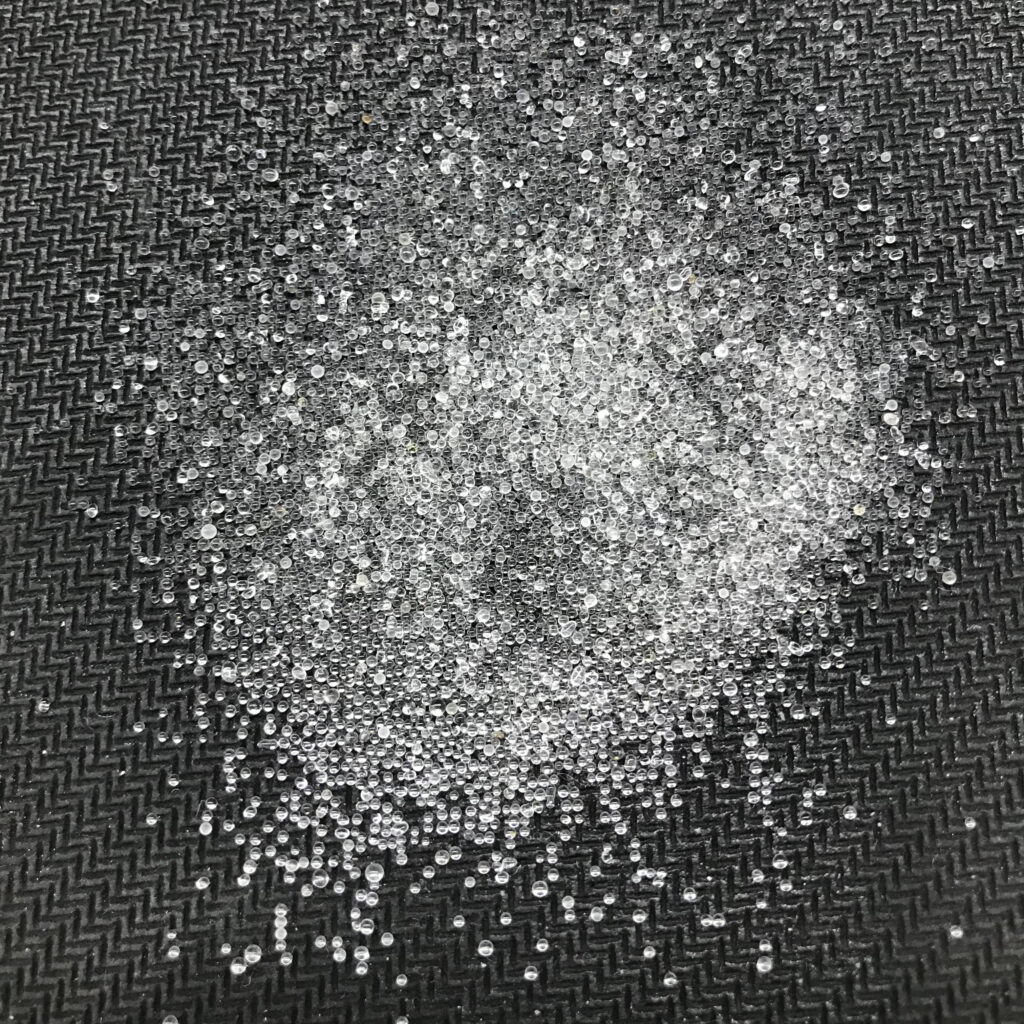Glass beads as abrasives are a specific and widely used type of media in the world of surface finishing.
TYPICAL CHEMICAL ANALISIS [%]:
| SiO2 | Na2O | Fe2O3 | Al2O3 | MgO | CaO | Other |
| ≥65.0% | ≤14.0% | ≥0.15% | 0.5-2.0% | ≥2.5% | ≤8.0% | 2.0% |
PHYSICAL PROPERTIES:
| Bulk Density | Real Density | Mohs Hardness | HRC hardness | Roundness | Magnetic |
| 1.5g/cm3 | 2.5g/cm3 | 6-7 | 46 | ≥80.0% | ≤0.1% |
AVAILABLE SIZES
| Sandblasting | 20# 30# 40# 50# 60# 70# 80# 90# 100# 120# 140# 150# 170# 180# 200# 220# 240# 325# |
| Grinding | 0.8-1.2mm 1-1.5mm 1.5-2mm 2-2.5mm 2.5-3mm 3.5-4mm 4-4.5mm 4-5mm 5-6mm 6-7mm |
| Road Marking | BS6088A BS6088B EN1424 EN1423 AASHTO TYPE1 AASHTO TYPEII JIS NO.1 JIS NO.2 |
What Are Glass Bead Abrasives?
Glass bead abrasives are precisely manufactured spherical beads made from soda-lime glass. They are not sharp or angular like sand or other crushed abrasives. Their round, consistent shape is their defining characteristic and the source of their unique finishing properties.
They are typically used in air-blast or wheel-blast equipment, where they are propelled at a surface to clean or finish it.
Key Characteristics & Advantages
Spherical Shape:
Peening Effect: Instead of cutting into the surface, they impact it, creating dimples. This compresses the surface layer, inducing beneficial compressive stresses that improve fatigue life and resistance to stress corrosion cracking. This process is known as shot peening.
Smooth, Satin Finish: They produce a uniform, low-roughness, matte (satin) finish without removing significant base material. They deburr by wearing down sharp edges rather than cutting them away.
Non-Destructive to Part Geometry: Because they don’t cut or etch the surface, they preserve critical part dimensions and tolerances.
Chemically Inert:
Glass is non-metallic and non-reactive. This makes it ideal for use on stainless steel, aluminum, and other sensitive metals where ferrous contamination (embedded iron particles that can cause rust) is a major concern.
Reusable:
High-quality glass beads have good durability and can be recycled many times within a closed-loop blasting system before they eventually fracture and break down into dust.
Versatile Size and Hardness:
Available in a wide range of standard mesh sizes (e.g., 50-70, 70-100, 100-170) to achieve different levels of finish and peening intensity.
Their hardness (around 5-6 on the Mohs scale) is effective for cleaning and finishing but gentle enough not to damage the substrate.
Common Applications
Glass beads are chosen for specific outcomes that require a balance of cleaning, finishing, and surface enhancement without aggression.
Deburring: Smoothing away micro-burrs left on machined, stamped, or cast parts.
Shot Peening: For automotive (valve springs, connecting rods), aerospace (turbine blades, landing gear), and other high-stress components to enhance fatigue strength.
Surface Cleaning & Preparation:
Removing light rust, mill scale, paint, and carbon deposits.
Creating a clean, matte surface ideal for subsequent coating or painting (provides a good anchor profile, or “key”).
Cosmetic Finishing: Producing a uniform satin or matte finish on consumer products, tools, and architectural metalwork.
Restoration: Cleaning and restoring stone, brick, and historic metalwork without damaging the underlying material.
Stripping: Gently removing coatings from delicate substrates without damaging the base material.


